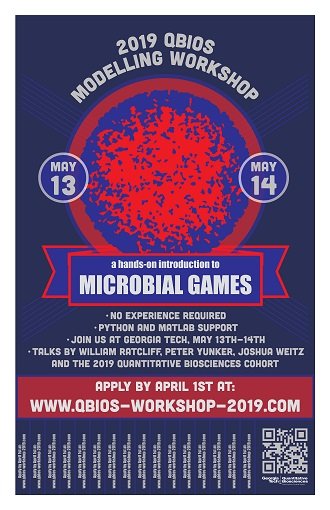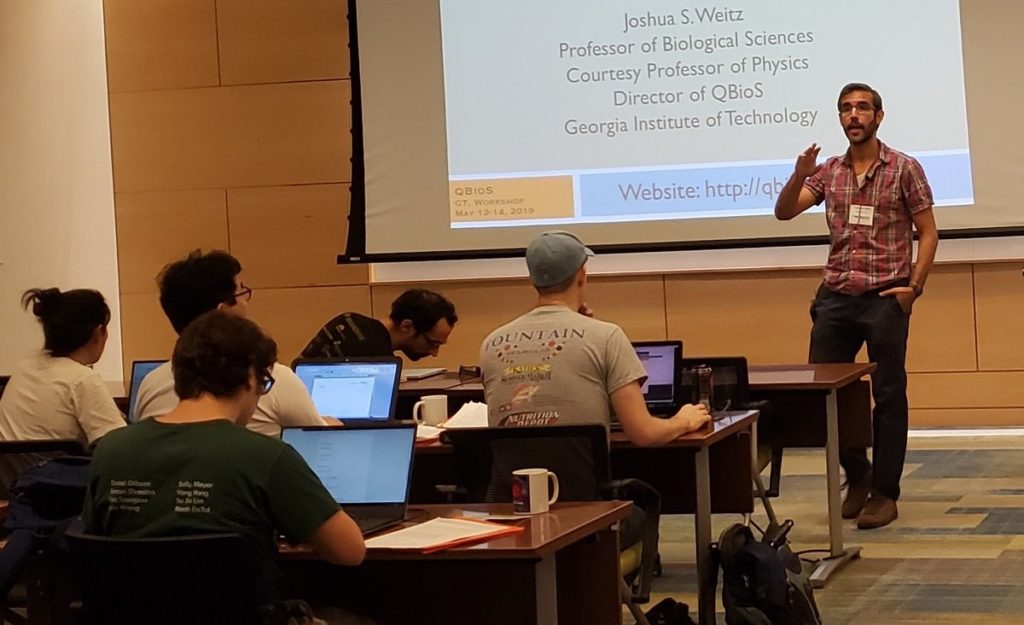Elma Kajtaz was stumped during her PhD research, trying to make sense of the measurements she was taking of muscle tissue samples and how the samples responded to stimuli. Like many biology graduate students, she was in a department that was focused on biological sciences and did not include much quantitative science in the curriculum. But as Kajtaz was looking at her data, which varied wildly between experiments, she realized she could not rely solely on her knowledge of statistics to explain what was going on and needed training in computation.

The annual QBioS workshop is open to students from Georgia Tech, as well as from other schools in the Atlanta area, such as Emory University and Spelman College.
Fortunately, Kajtaz was at Georgia Tech, and her advisor told her about a new interdisciplinary graduate program called Quantitative Biosciences, or QBioS, that had just been created there in 2015. She switched into the program and took its introductory course, Foundations in Quantitative Biosciences, which Kajtaz says was "exactly what I needed." Instead of wading through computer programming courses and trying to synthesize the material on her own, the QBioS course led her through mathematical and computational approaches to study a range of life science systems, from molecules to entire ecosystems. And it gave her a starting place to develop a model for her puzzling data.
In the last 10 to 20 years, the number of interdisciplinary biology graduate programs has expanded, and now "almost all of the major universities in the United States will have programs of this nature," says Phillip Sharp, professor of biology at Massachusetts Institute of Technology (MIT) and 1988 Lasker Basic Medical Research Laureate. Many of the programs marry biology with engineering or computational science, offering PhD degrees in bioengineering or bioinformatics, respectively. A few train graduate students, as QBioS does, in both biology and a range of quantitative sciences including physics and mathematics. And while many universities don't offer a formal PhD program in quantitative biology, a growing number have interdisciplinary research institutes, including the Koch Institute for Integrative Cancer Research at MIT, where Sharp is a professor, that give research and training opportunities to graduate students from more traditional biology PhD programs. All of these avenues are helping to fuel what Sharp and his colleagues at MIT call the "Convergence Revolution."
Convergence melds the methods and ideas of biologists, mathematicians, and other quantitative scientists. As Sharp and his colleagues wrote in their reports about convergence in 2011 and 2016, it could transform healthcare and other areas of society. But it will not happen without a shift in education. It is a message that Joshua Weitz, founding director of QBioS, took to heart as he developed his program. "[The reports] have been highlighting the gap in not just what we want out of convergence research, but how we get there. And how we get there has to do with graduate training," Weitz says.
Training the next generation of scientists to practice convergence and quantitative biology has some challenges that traditional single-discipline programs often do not have to deal with, such as readying students to work in interdisciplinary teams and speaking the language of other disciplines. Coursework can get students part of the way there; indeed, biology PhD students at MIT as well as students in QBioS and other newer interdisciplinary PhD programs are required to take at least one quantitative biology course.
But in many cases, quantitative biology PhD programs and research institutes are going beyond the usual training framework based on coursework, seminars, and independent research. Students working in labs at the Koch Institute attend presentations from engineering and clinical trainees about real-world problems and solutions in their fields as part of ongoing series called the Engineering Genius Bar and the Doctor Is In, respectively. QBioS fosters team building by having its first-year graduate students organize and teach a two-day workshop about a certain aspect of quantitative biology, such as developing computer models, to graduate students outside their program with less computational experience.

Joshua Weitz, founding director of the Quantitative Biosciences (QBioS) PhD program at Georgia Tech, welcomes attendees to a QBioS workshop.
As the new crop of quantitative biology PhD programs and research institutes invent themselves, sometimes from the ground up, they are seizing the chance to try out some bold new training strategies. "When new institutes come up, they want to make a name for themselves; they want to differentiate themselves," says Neal Woodbury, professor of molecular sciences and faculty member in the Biodesign Institute at Arizona State University. The Biodesign Institute, which opened in 2004, is testing a program where employees of nearby biotech companies do research in a lab at the institute, bringing their commercial perspectives into the academic setting, and can ultimately earn a PhD degree from one of the biology graduate programs at ASU.
In another example, PhD students at University of California, San Diego (UCSD) who specialize in the quantitative biology (qBio) program, which began in 2015, do a series of projects in the so-called hacker lab at the end of their first year, instead of the usual rotations through labs that most PhD programs require. It is a "magical place," says UCSD assistant professor and qBio faculty member Elizabeth Villa, full of 3-D printers, microscopes, and other fancy equipment, and graduate students are set loose under the supervision of professors to build a device or software to solve some biological problem.
All this training costs money, both to support the students in interdisciplinary programs and to help institutions develop new programs and courses around quantitative biology. Over the last decade, government agencies, including the US National Institutes of Health (NIH) and Department of Energy, and private foundations have stepped up with the funding that Sharp, in a 2011 article, explained was so necessary. Nevertheless, Sharp says, more money is still needed to expand existing programs and build new ones. "The demand is going to be enormous… at the interface between computation and life science and biomedical science, job opportunities in the private and public sector are enormous," Sharp says.
Many universities are actually doing a better job at training undergraduates in crosscutting science than providing such experiences to graduate students, often by giving science majors opportunities to get research experience in different science disciplines. "We are telling all these students at the undergrad level that interdisciplinary is great, and then what are the options for grad school?" Weitz says. One of the motivations for the QBioS program at Georgia Tech, Weitz adds, was to give students that option.
The majority of science PhD degrees are still in a single discipline, whether biology, microbiology, physics, or others. Weitz predicts this will change as more interdisciplinary programs are launched. But in the meantime, many graduate students find themselves, as Kajtaz was early in her PhD research at Georgia Tech, trying to piece together the knowledge they need from short workshops and tutorials offered through universities, organizations, and online courses. "[These] are like boot camps, designed really for quickly bringing you up to speed on particular topics [and techniques]… they are not based around general concept development," says Louis Gross, director of the National Institute for Mathematical and Biological Synthesis (NIMBioS) at the University of Tennessee Knoxville (UTK). NIMBioS hosts tutorials in various mathematical and computational methods for graduate students at UTK and beyond.

Batbileg Bor (L) Einat Schnur (R) discuss a team-based research project during the MBL summer Physiology course in 2013. Credit, Tom Kleindinst/MBL
In a few cases, courses outside of graduate programs are offering the depth of graduate courses and the breadth of interdisciplinary science. The Physiology Course at Woods Hole Marine Biological Laboratory (MBL), a private research institution in Massachusetts, brings together a mix of biology and quantitative science graduate students every summer for 7 weeks for boot-camp-style technical training in biological, mathematical, and computational techniques, followed by three fast-tracked, team-based research projects.
This type of course may be hard to replicate, partly because of the time commitment for the professors who run it, says Ron Vale, a professor of cellular and molecular pharmacology at University of California, San Francisco (UCSF) who has been a director of the MBL physiology course. Nevertheless, it has helped shape the curriculum of graduate programs, such as the UCSF Integrative Program in Quantitative Biology (iPQB), says Vale, 2012 Lasker Basic Medical Research Laureate.
Scientists who have been through quantitative biology training say it opens up many jobs opportunities. Kajtaz, who is now a data scientist at Aetna Healthcare, is applying the tools and techniques she learned in QBioS courses to analyze health risks at a population level. Villa, the UCSD professor, took the MBL physiology course as a graduate student in 2007 and was transformed from a computational and theoretical scientist to an experimentalist. For scientists with a less quantitative background, she says that learning computer modeling means you can work on any problem, from studying how blood flows to how planes land. "It allows you to have a global view of the problem and a better way of thinking about testable predictions."
by Carina Storrs
